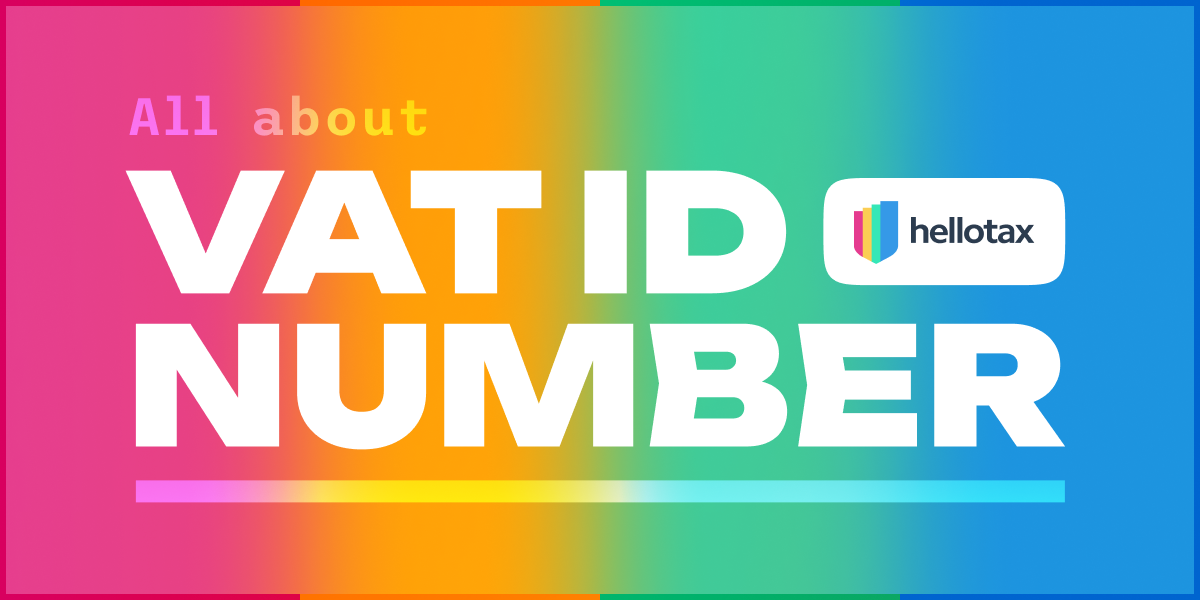The VAT identification number (VAT ID) and the tasks associated with it can be confusing and are generally a rather unwelcome topic. In our VAT ID Guide you will find everything you need to know about VAT, the structure, when you need such a number and much more.
Antonia Klatt
Last Updated on 6 September 2023
What is a VAT ID?
The VAT Identification number identifies all companies in the European Union and is indispensable for intra-European trade. It can be obtained by registering vor VAT.
When trading within the EU (intra-community supply/service) a VAT ID for making sure that taxes are paid is mandatory. So the VAT ID number is then needed to identify all sellers and buyers (if businesses) and to ensure a smooth handling and payment of VAT and to avoid fraud.
Following a registration for VAT you will need to fulfill regular VAT duties, like the submission of VAT returns and other important documents. Those duties can be automated with the hellotax VAT software. Find out more during a free consultation with our VAT specialists!

Book a free consultation
Our VAT experts are happy to help you. Book a free consultation today!
Find out more about VAT IDs in Europe
How is the VAT number structured?
In principle, the VAT number consists of a prefix (country code at the beginning) and a suffix (numbers/letters for identification).
| VAT ID by country | Example |
| VAT ID Germany | DE123456789 |
| VAT ID United Kingdom | GB123456789 GB123456789012 GBAB123 |
| VAT ID France | FRXX123456789 |
| VAT ID Spain | ESX1234567X |
| VAT ID Italy | IT12345678901 |
| VAT ID Poland | PL1234567890 |
| VAT ID Czech Republic | CZ12345678 CZ123456789 CZ1234567890 |
When do you need a VAT Identification Number (VAT ID)?
Typical cases in which a foreign entrepreneur must register for a local VAT number:
- Domestic Supplies: If you have a business established in an EU member state and make taxable supplies within that state, you typically need a VAT ID from your home country’s tax authority.
- Cross-border Supplies within the EU: If your business is supplying goods or services to businesses in other EU member states, you might need a VAT ID to report and record these transactions. The recipient business will often require your VAT ID for their own accounting and VAT reporting purposes.
- Distance Sales: If you’re selling goods to consumers in another EU member state and exceed the distance sales threshold set by that country, you would typically need to register for a VAT ID in the destination country.
- Acquiring Goods from another EU Member State: If your business purchases goods from another EU member state, you might need to obtain a VAT ID to account for the VAT on the acquisition.
- Storing Goods in another EU Member State: If you store goods in a warehouse or on consignment in another EU country, you may need to register for a VAT ID in that country.
- Organizing events or conferences: If you’re organizing events, conferences, or exhibitions in an EU country where you’re not established, and if the services are subject to VAT in that country, you might need a VAT ID.
- Electronic Services: If you provide digital services to consumers in the EU, you might need a VAT ID, especially if you exceed the mini one-stop-shop (MOSS) thresholds.
- E-commerce: With the evolution of e-commerce and changes in VAT rules, companies that sell goods online may need to have a VAT ID in the destination countries, especially after the introduction of the EU’s new e-commerce VAT rules from July 2021.
- Installation or Assembly: If you sell goods that require installation or assembly in a customer’s premises in another EU member state, this might create a need for a VAT ID in that state.
- Using Online Marketplaces: If you’re selling through online marketplaces in the EU, some platforms might ask for your VAT ID as part of their compliance with local regulations.
- Reverse Charge Mechanism: In certain business-to-business (B2B) transactions, the responsibility for reporting VAT can shift from the seller to the buyer. In these cases, both parties typically need to provide their VAT IDs.
It’s essential to remember that the need for a VAT ID and the VAT rules can vary from one EU member state to another. If you believe you might need a VAT ID, or if you’re unsure, it’s advisable to consult with local tax advisors or authorities to ensure compliance.
Where can I apply for a VAT identification number?
The VAT number can either be applied for online at the respective tax office, by mail or, and this is probably the easiest way, directly in the hellotax tax software.
What information is required for the VAT ID registration?
In principle, different documents have to be submitted for registration in each country, but a few documents remain the same (although unfortunately, these are often only available in the local language).
It can be assumed that the following documents (+ others) are necessary for the registration:
- Proof of VAT or tax registration in the country of origin
- The certificate of incorporation of the company (copy)
- The articles of association of the company (copy)
- An extract from the national register of companies as proof of existence,
- Proof of the planned trade (e.g. contracts or invoices)
Where can I check the VAT ID?
Since the different VAT numbers are also regarded as a form of security from a tax perspective, online merchants should check VAT numbers regularly.
If, for example, you do not have to pay VAT using the reverse charge procedure, you are only exempt from paying VAT if the company based abroad also fulfills all tax law requirements.
There are some tools that allow you to do the check-in a few minutes.
The numbers are needed for invoices in most cases anyway and if the number is missing or incorrect, the invoicing party may have to pay the VAT itself in its own country.
The VAT number can be checked with the VIES, a VAT ID Checker, or rather search engine, of the European Commission.
Where can I find my VAT number?
Your own VAT number can be found on invoices, on tax reports and you can also retrieve and check it online. The latter is now not necessarily relevant for the one tax number, but for example for cooperation with potential business partners.
Where must the VAT no. be stated?
Whoever sells within the EU, e.g. B2B from England to Germany, must indicate the VAT number on the invoice. In general, it must be quoted on all invoices relating to intra-community supplies/services – by both the sender and the recipient.
Of course, the VAT ID is also important in other cases, for example in all related reports and declarations that have to be submitted to the tax office.
Tax number, tax identification number & VAT number
In all EU countries, there are different kinds of tax numbers with different functions and different names. Usually, these 3 have to be distinguished.
Tax Number
The tax number is a personal number – it is based on the taxpayer’s place of residence and is composed of different abbreviations. After moving to a new location, you will usually also receive a new tax number.
Tax Identification Number
The tax identification number is also a personal number but it doesn’t change and usually, it remains the same until the rest of a person’s life.
VAT Identification Number
The VAT identification number (VAT ID) is only required by entrepreneurs, the employee has nothing to do with this tax number. Whoever provides goods and services in Europe also needs a VAT number as (almost) all goods and services within the EU are subject to VAT.
VAT ID number USA
As many people asked us about a VAT ID USA in the past, please not that there is no VAT or GST in the US. However, there is something similar, the so-called sales tax. This tax differs from state to state and can be compared to the VAT number in Europe. More about Sales Tax in the US->



![Apply for a VAT Number [GUIDE]: <br>Instructions, Deadlines & more](https://hellotax.com/blog/wp-content/uploads/2020/02/Umsatzsteuer-ID-beantragen.jpg)




